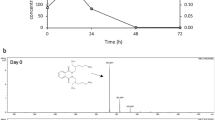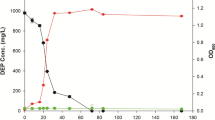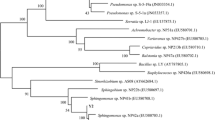Abstract
A Sphingobium sp. strain isolated from radioactive solid waste management site (RSMS) completely degraded 7.98 g/L of tributyl phosphate (TBP) from TBP containing suspensions in 3 days. It also completely degraded 20 mM dibutyl phosphate (DBP) within 2 days. The strain tolerated high levels of TBP and showed excellent stability with respect to TBP degradation over several repeated subcultures. On solid minimal media or Luria Bertani media supplemented with TBP, the RSMS strain showed a clear zone of TBP degradation around the colony. Gas chromatography and spectrophotometry analyses identified DBP as the intermediate and butanol and phosphate as the products of TBP biodegradation. The RSMS strain utilized both TBP and DBP as the sole source of carbon and phosphorous for its growth. The butanol released was completely utilized by the strain as a carbon source thereby leaving no toxic residue in the medium. Degradation of TBP or DBP was found to be suppressed by high concentration of glucose which also inhibited TBP or DBP dependent growth. The results highlight the potential of Sphingobium sp. strain RSMS for bioremediation of TBP and for further molecular investigation.





Similar content being viewed by others

References
Ahire KC, Kapadnis BP, Kulkarni GJ, Shouche YS, Deopurkar RL (2011) Biodegradation of tributyl phosphate by novel bacteria isolated from enrichment cultures. Biodegradation 23:165–176
Altschul SF, Gish W, Miller W, Myers EW, Lipman DJ (1990) Basic local alignment search tool. J Mol Biol 215:403–410
Ames BN (1966) Assay of inorganic phosphate, total phosphate and phosphatases. In: Elizabeth F. Neufeld VG (ed) Methods in Enzymology Vol 8. Academic, p 115–118
Anon (1992) Treatment and conditioning of radioactive organic liquids. In: IAEA (ed). IAEA, Vienaa. http://www-pub.iaea.org/MTCD/publications/pdf/te_656_web.pdf. Accessed 16 Jan 2013
Berne C, Allainmat B, Garcia D (2005) Tributyl phosphate degradation by Rhodopseudomonas palustris and other photosynthetic bacteria. Biotechnol Lett 27:561–566
Berne C, Montjarret B, Guountti Y, Garcia D (2004) Tributyl phosphate degradation by Serratia odorifera. Biotechnol Lett 26:681–686
Eden PA, Schmidt TM, Blakemore RP, Pace NR (1991) Phylogenetic analysis of Aquaspirillum magnetotacticum using polymerase chain reaction-amplified 16S rRNA-specific DNA. Int J Syst Bacteriol 41:324–325
Healy TV (1976) Fuel reprocessing solvent tributyl phosphate: its degradation, clean-up, and disposal. Management of radioactive waste from the nuclear fuel cycle. In: IAEA, Vienna, vol 1
Hernandez O (2001) Tributyl phosphate-SIDS initial assessment report for 12th SIAM. UNEP publications. http://www.chem.unep.ch/irptc/sids/OECDSIDS/126-73-8.pdf. Accessed 17 Jan 2013
Jeong B, Klm H-W, Owen S, Dick RE, Macaskie L (1994) Phosphoesterase activity and phosphate release from tributyl phosphate by a Citrobacter sp. Appl Biochem Biotechnol 47:21–32
Kunihiro M, Ozeki Y, Nogi Y, Hamamura N, Kanaly RA (2013) Benz[a]anthracene biotransformation and production of ring fission products by Sphingobium sp. strain kk22. Appl Environ Microbiol 79:4410–4420
Macaskie LE (1991) The application of biotechnology to the treatment of wastes produced from the nuclear fuel cycle: biodegradation and bioaccumulation as a means of treating radionuclide-containing streams. Crit Rev Biotechnol 11:41–112
Manohar S, Srinivas C, Vincent T, Wattal PK (1999) Management of spent solvents by alkaline hydrolysis process. Waste Manage 19:509–517
Marchesi JR, Sato T, Weightman AJ, Martin TA, Fry JC, Hiom SJ, Dymock D, Wade WG (1998) Design and evaluation of useful bacterium-specific PCR primers that amplify genes coding for bacterial 16S rRNA. Appl Environ Microbiol 64:795–799
Nakamura A (1991) International programme on chemical safety—environmental health criteria, 112-tri-n-butyl phosphate. World Health Organisation. Geneva. http://whqlibdoc.who.int/ehc/WHO_EHC_112_eng.pdf. Accessed 3 Apr 2012
Owen S, Jeong BC, Poole PS, Macaskie LE (1992) Tributyl phosphate degradation by immobilized cells of a Citrobacter sp. Appl Biochem Biotechnol 34–35:693–707
Rosenberg A, Alexander M (1979) Microbial cleavage of various organophosphorus insecticides. Appl Environ Microbiol 37:886–891
Schulz WW, Navratil JD (1984) Science and technology of tributyl phosphate, vol 1. CRC, Boca Raton
Skerman VBD (1967) A guide to the identification of the genera of bacteria. The Williams & Wilkins Co, Baltimore
Takeuchi M, Hamana K, Hiraishi A (2001) Proposal of the genus Sphingomonas sensu stricto and three new genera, Sphingobium, Novosphingobium and Sphingopyxis, on the basis of phylogenetic and chemotaxonomic analyses. Int J Syst Evol Microbiol 51:1405–1417
Thomas RA, Macaskie LE (1998) The effect of growth conditions on the biodegradation of tributyl phosphate and potential for the remediation of acid mine drainage waters by a naturally occurring mixed microbial culture. Appl Microbiol Biotechnol 49:202–209
Thomas RA, Morby AP, Macaskie LE (1997) The biodegradation of tributyl phosphate by naturally occurring microbial isolates. FEMS Microbiol Lett 155:155–159
Thomas RAP, Macaskie LE (1996) Biodegradation of tributyl phosphate by naturally occurring microbial isolates and coupling to the removal of uranium from aqueous solution. Environ Sci Technol 30:2371–2375
Acknowledgments
The authors thank Anubrata Das and A.S Rao for the isolation of the RSMS strain, Chitra Seetharam Misra for the valuable suggestions during manuscript preparation, Dr. Kayzad Nilgiriwala for the help in 16S rRNA gene sequencing, and Mrs. Saraswathi Perumal for the technical help.
Author information
Authors and Affiliations
Corresponding author
Electronic supplementary material
Below is the link to the electronic supplementary material.
ESM 1
(PDF 914 kb)
Rights and permissions
About this article
Cite this article
Rangu, S.S., Muralidharan, B., Tripathi, S.C. et al. Tributyl phosphate biodegradation to butanol and phosphate and utilization by a novel bacterial isolate, Sphingobium sp. strain RSMS. Appl Microbiol Biotechnol 98, 2289–2296 (2014). https://doi.org/10.1007/s00253-013-5158-5
Received:
Revised:
Accepted:
Published:
Issue Date:
DOI: https://doi.org/10.1007/s00253-013-5158-5



